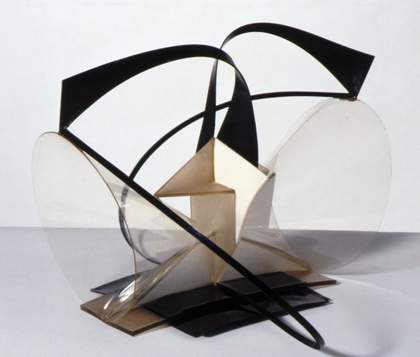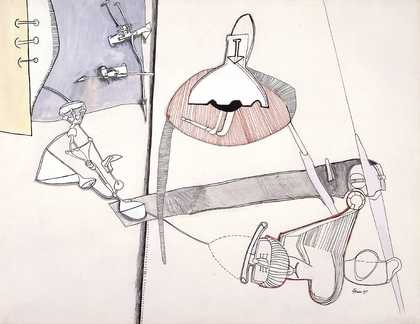As Sebastiano Barassi and Yve-Alain Bois point out in their contributions to this symposium, Alois Riegl’s essay ‘The Modern Cult of Monuments’, 1903, offers a useful set of co-ordinates for thinking about the Tate’s Gabo project, both because Riegl is explicitly addressing the problem of restoration and because, rather than advocating one attitude or another, he offers a taxonomy of possible positions.
Most of the papers submitted by the symposiasts accept that the Gabo project should be governed by what Riegl calls historical-value. He writes: ‘The historical value of a monument arises from the particular, individual stage it represents in the development of human activity in a certain field … The more faithfully a monument’s original state is preserved, the greater its historical value’. In cases of decay, the historical imperative is twofold: arrest further decay so that the artefact retains the maximum trace of its original condition, and make a replica that provides the fullest possible experience of the original. As Riegl writes, this reversal of aging ‘must be done not to the monument itself, but only to a copy or a mental reconstruction of it’.
But a replica, even when fenced round by warning labels, can quickly assume all the powers of the original, especially in cases where the original is lost, damaged to the point that it cannot be favourably exhibited, or unstable to the point that it cannot be exhibited at all. Maria Gough and Nancy Troy outline respectively how the reception of Alexander Rodchenko’s and Piet Mondrian’s work has been distorted by facsimiles that have more to do with a certain kind of minimalist aesthetic of the 1970s than with the original objects. This power of replicas for both good and ill no doubt explains why Jackie Heuman and Lyndsey Morgan in their paper regard the creation of a three-dimensional replica as more ‘controversial’ than that of a digital image. Having seen the exhibition Gods in Color: Painted Sculpture of Classical Antiquity at Harvard’s Sackler Museum, I can testify to the indelible effect of a three-dimensional replica, especially an unexpected one. Still, one could well argue that today the digital image is even more powerful than the object in the round, given current modes of art consumption.
Restoration alters originals; replication often supplants them. This leads to a further thought: the replica maker is unconstrained by an actual physical-historical matrix. The field is open, hence the temptation to make the work somehow better than it was. I am not thinking here of the excesses that Gough and Troy describe: even within the limits of the Riegl historical-value, such a thought can occur.
In the case of Gabo, the materials used for a replica would necessarily be different anyway due to the inherent vice of the original materials, and this difference would have a visual component. Should the replicator attempt to undo it? Alex Potts suggests intriguingly that the cleaner look and fit of modern plastics might be welcomed on the basis that it would best convey to a contemporary audience the ‘ultra-modernity the original work once had’. This position might seem to be an instance of Riegl’s newness-value, but it is actually a more sophisticated version of his historical-value, one that attempts to take into account the dialectical relation of past and present and the historically variable nature of reception. Further, in the case of Naum Gabo such a position could be supported by appeal to the artist’s general intentions regarding modernity as well as to his practice (which Christina Lodder describes) of seeking out newer materials in his own replications. But, of course, that look of ultra-modernity would only last so long, owing to the twin forces of perceptual ‘advance’ and material decay.
The matter of artistic intention is another worm in the apple. As Henry Lydiate explains, living artists have both legal and moral rights in the matter of replication (although they can also give up those rights, as James Meyer describes in the case of Donald Judd). This tends to give artistic intention a special role in the matter of replication generally, whether the artist is alive or not. Thus, we learn in various papers about the attitudes of Gabo, Eva Hesse, Judd, Carl Andre, and Hélio Oiticica to the replication of their works. Michelle Barger proposes that ‘full replication … seems in conflict with Hesse’s approach’, while in his fascinating dialogue with Mark Godfrey, Anthony McCall suggests that a digital remake of one of his own films would be ‘completely true to the original conception … but with none of the irregularities of the film that was actually made’ – although he goes on to propose that he would give such a remake a title reflecting its status as a kind of software upgrade.
Taken together, the papers reveal a spectrum of artist’s attitudes to the survival of their works, from an insistence on ephemerality and obsolescence to an obsession with replication and renewal. This means that any given appeal to an artists’ intentions, while itself an historicist strategy, will not necessarily yield a result that favours historical preservation. We should also acknowledge, with Riegl, that the advocacy of decay has its own historical dimension. Riegl identified a renewed cult of ruins in his own time (the early twentieth century) and saw it as a natural outgrowth of the historicist bias of the previous century, since it took the values of history and generalised them, from historical recreation to History as such, as process.
Margaret Iversen’s paper is one of the few that questions replication from the vantage-point of Riegl’s category of age-value, suggesting that such aspects of the encounter with art as ‘intersubjectivity, memory, and the unconscious’ are threatened by replicas, and that the patina of time has its own suggestive value. But her suggestion, that the Tate ‘display Gabo’s plastic sculptures in such a way that the history of their failed experimental material is acknowledged’, is a retreat to a safer, more common ground – to history with a small h. In the same way, Anna Dezeuze suggests that the fragments of Robert Morris’s interactive work be ‘displayed in a glass case as the relics of yet another failed project’. This is not a cult of ruins but a polemical historicism.
A more radical gesture would be to put the Tate’s original Gabos on permanent display regardless of the consequences. Viewers could then witness the dramatic, discontinuous warping and cracking of the pieces over time. By presenting these fragments-in-process next to the three-dimensional replicas, and perhaps even with digital images or holograms as mediators, their self-destruction would be thrown into relief. But rather than demonstrate the material failures of Gabo’s ultra-modern project, this display would say more about our own time and its Kunstwollen (what Riegl calls relative art-value) in all its conceptual and performative desires, where the performers are the materials themselves.




